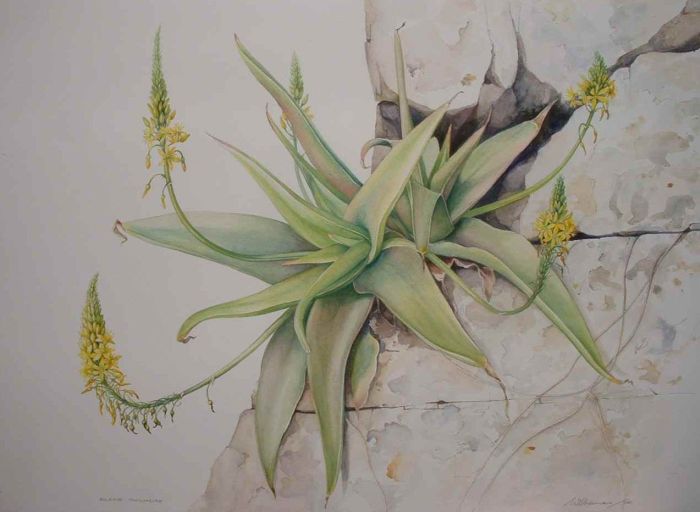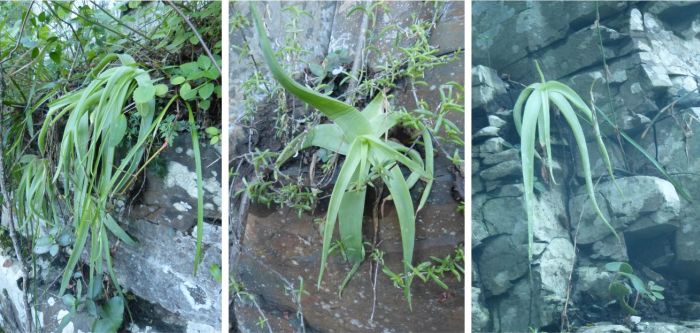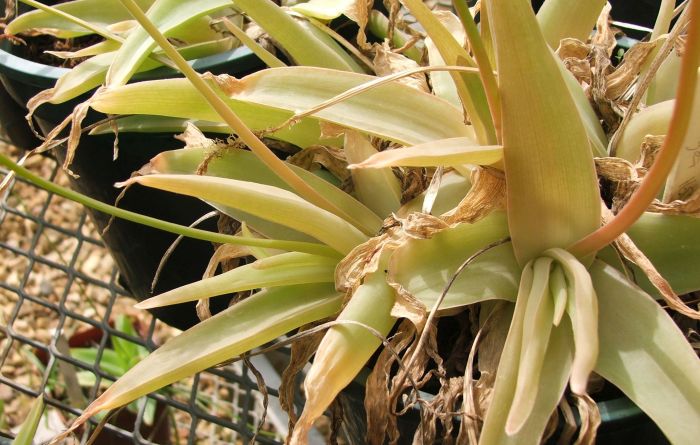Bulbine thomasiae
Bulbine thomasiae Van Jaarsv.
Family: Asphodelaceae
Common names: Mbashe bulbine (Eng.); mbashekopieva (Afr.)
Introduction
Bulbine thomasiae is an obligatory cliff-hugger, with rosettes of dull green, soft, succulent leaves that grow from the shale cliff faces along the Mbashe River in the Eastern Cape. It flowers in spring when the solitary inflorescence appears, bearing yellow flowers. Best grown in containers.

Fig. 1. The Mbashe bulbine (Bulbine thomasiae) in full flower in habitat along sheer upper cliffs of the Mbashe River, near Colleywobbles.
Description
Description
The rosulate succulent plants grow in small, tight clusters with up to 8 heads, sometimes pendent from the rock face. Rosettes are up to 150 mm long and high, 150 mm in diameter. Each rosette with an ovoid tuber, about 20 ´ 18 mm, tapering slightly towards the neck, sparsely covered with few soft fibres. The roots are terete, up to 2 mm in diameter, grey-brown. The leaves are very soft and fragile, up to 7, drawn together during dry periods, ascending spreading or curving downwards. The leaf blade (lamina) is linear-lanceolate to triangular-lanceolate, 80–170 ´ 14–20(–30) mm, the base clasping; channelled to flattened above, rounded below, glaucous, becoming reddish pink during dry winters, faintly translucent and striate, covered with short, pointed papillae; apex acute, mucronate; margins acute, translucent, minutely ciliate.

Fig. 2. A close-up of the Mbashe bulbine (Bulbine thomasiae) in full flower in habitat along sheer upper cliffs of the Mbashe River, near Colleywobbles.
The inflorescence is 250–290 mm long, the racemes subcapitate, 40–80 mm long, pointed, densely flowered. The flowers are secundly arranged, the stalk of the inflorescence flattened at base, 4–6 mm in diameter, basal half biconvex, minutely ciliate, subterete upwards; bracts deltoid-ovate, boat-shaped (cymbiform), 4–5 ´ up to 3 mm, the leaf drawn to a narrow point (acuminate), the leaf keel and margins minutely ciliate, clasping; pedicels 15–20 mm. The perianth becoming reflexed, spreading, about15 mm in diameter when fully expanded, stellate; tepals orange-yellow, slightly channelled and incurved at tips, outer tepals oblong-obovate, up to 8 ´ 3 mm, inner tepals ovate-lanceolate, up to 7.5 ´ 2.0 mm, obtuse. Stamens up to 6 mm long, bearded in distal quarter; anthers versatile, up to 1 ´ 0.8 mm. Ovary globose, up to 1.5 mm long. The fruiting capsule is obovoid, up to 5 ´ 4 mm, ascending to pendent. Seeds up to 2 mm in diameter, angular, black.
Flowering is mainly from midwinter to spring. Seeds are dispersed by wind in summer and early autumn.
Conservation Status
Status
Although the population is as yet only known from a single river system, the Mbashe River in the Eastern Cape, the plants grow on sheer, south-facing cliffs and are thus well protected by its inaccessible habitat and its distribution falls within a greater conservation region. Consequently it is assessed as Least Concern (LC) in the Red List of South African plants.

Fig. 3. Left: The Mbashe River cliffs, habitat of Bulbine thomasiae, with mainly eastern Valley Bushveld. Note the Euphorbia tetragona in the foreground. Right: Bulbine thomasiae in habitat during a dry period, the cluster filling a crevice in this sheer south-facing rock-face.
Distribution and habitat
Distribution description
Bulbine thomasiae is known only from the Mbashe River, from Collywobbles to near the river mouth, in the Eastern Cape. The Mbashe River, which drains parts of the Drakensberg, has dissected the local coastal mountains into a deep gorge just before it joins the Indian Ocean. It grows on the upper, sheer, south-facing cliffs at an altitude of 200–800 m. Temperatures are high in summer and mild in winter. The average daily maximum temperature is about 21ºC and average daily minimum about 12ºC. Rainfall occurs mainly in summer (October–May) and ranges from 500–600 mm per annum in the form of thunder showers.
The associated vegetation is Eastern Valley Bushveld of the Savanna Biome (Mucina et al. 2005). Associated cliff-dwelling succulents include Albuca batteniana, Aloe reynoldsii, Cotyledon orbiculata and C. pendens, Crassula orbicularis and C. planifolia, Delosperma sp., Gasteria excelsa, Haemanthus albiflos, Haworthia cymbiformis var. setulifera and Ornithogalum juncifolium.
The geology consists of Beaufort Shales (Karoo Supergroup).

Fig. 4. The Mbashe bulbine (Bulbine thomasiae), a solitary plant from an upper shale cliff face, growing with Delosperma laxipetalum.
Derivation of name and historical aspects
History
Bulbine thomasiae was named by the author in the magazine Aloe in 2003, for plants collected near Colleywobbles, Mbashe River in the Eastern Cape. It is named for Vicki Thomas, accomplished botanical artist, who painted the type plants (see illustration below).
Bulbine thomasiae is at once distinguished by its soft, fragile, dull-green, glaucous leaves of which the surface is minutely tuberculate, and also by its dividing nature, forming small clusters. It belongs to a group of summer rainfall, broad-leaved Bulbine species. It is closest to B. natalensis and B. cremnophila, both of which are also cliff dwellers. It is at once distinguished from these species by its flowers crowded together into a head. Bulbine natalensis is a much larger, solitary species with broad, spreading leaves (widely distributed from the Eastern Cape to KwaZulu-Natal) and B. cremnophila is a much smaller species with glaucous, smooth leaves. Both related species have elongated racemes and quite flattish leaves.

Fig. 5. The Mbashe bulbine (Bulbine thomasiae) illustration by Vicki Thomas.
Ecology
Ecology
Plants grow in a relatively safe cliff-face environment, from which larger herbivores are absent and it is also partially protected from fires. The flowers are pollinated by insects. The fruiting capsule ripens in summer and seeds are wind dispersed.
The highly succulent nature of the leaves enables the plants to survive periods of drought. The leaves become drawn together in an apical rosette, becoming slightly spreading only in the rainy season. The leaves are fragile and soft and out of reach from larger herbivores on the cliff face.
The leaf colour is glaucous (reflecting the light), also sparsely tuberculate. The slight translucent nature allows light to penetrate deeply, an adaptation helping the plants to cope with the shady cliff environment. The leaves become deciduous from the base, resulting in apical rosettes. After rain, the leaves becomes very turgid, but are deeply channelled during dry periods, an adaptation to dry periods on the cliff.
Bulbine thomasiae divides, forming dense clusters. The continual division and filling of crevices represents an efficient vegetative backup dispersal strategy. Individual branches of the clusters will root and continue to grow, maximising survival (vegetative backup). Detached clusters or heads will also root if they fall into a new crevice.

Fig. 6. The Mbashe bulbine (Bulbine thomasiae) growing on shady cliffs, note how the leaves become drawn out and drooping.
Uses
Use
No medicinal or cultural uses have been recorded.

Fig. 7. A close-up of the leaves of Bulbine thomasiae in cultivation. Note the faint striations.
Growing Bulbine thomasiae
Grow
Bulbine thomasiae can be grown with relative ease from either seed or dividing the plants. It is a cliff-habitat specialist and it is best to grow it as a containerized plant under controlled conditions. In its habitat at Colleywobbles, rain occurs mainly from spring to autumn but some rain also may fall in winter. Best to water well during summer and keep dry in winter. The plant is also frost-prone and should be protected in the winter. The young plants start solitary, soon dividing and forming small, dense clusters.
The soil should be sandy and well-drained, as is found in its natural habitat. They will react well to any fertiliser but organic fertilisers, such as well broken down compost, are best. As a pot plant, it is best on a balcony or windowsill.
Divide plants at any time of the year, and plant in a shallow tray in a sandy mixture, such as peat, sand and polystyrene, and keep moist. Rooting is within 3 weeks and once well rooted transfer to individual containers. Place container in a shady position but with full light. The south side of a building is ideal.
Sow seed in spring or summer in a sandy medium. First moisten the substrate with a fine rose. Cover the seed lightly with a thin layer of sand. Keep moist and in a shady position. Germination is usually within 3 weeks and the young seedlings are relatively fast growing. Transplant seedlings to individual containers once large enough to handle.
Plants are relatively disease free but slugs and snails can sometimes be a problem.
References
- Manyama, P.A. & Kamundi, D.A. 2006. Bulbine thomasiae Van Jaarsv. National Assessment: Red List of South African Plants version 2020.1. Accessed on 2021/04/19
- Mucina, L. & Rutherford, M.C. (eds) 2006. The vegetation of South Africa, Lesotho and Swaziland. Strelitzia 19. South African National Biodiversity Institute, Pretoria.
- Van Jaarsveld, E.J. & Forster, P.I. 2001. Bulbine. In U. Eggli, Sukkulenten Lexicon (Band 1). Einkeimblattrige Pflanzen (Monocotyledonen). Ulmer, Stuttgart.
- Van Jaarsveld, E.J. & Van Wyk, A.E. 2003. Four new cliff-dwelling Bulbine taxa (Asphodelaceae) from the Eastern and Western Cape. Aloe 40(1): 4–7.
- Williamson, G. 2000. Four new, succulent Bulbine species (Asphodelaceae) from the Western and Eastern Cape Provinces of the Republic of South Africa. Bradleya 18: 31–40.
Credits
Ernst van Jaarsveld
Kirstenbosch National Botanical Garden (Retired 2015)
Babylonstoren Farm
Extraordinary senior lecturer and researcher,
Department of Biodiversity and Conservation, University of the Western Cape
April 2021
Plant Attributes:
Plant Type: Succulent
SA Distribution: Eastern Cape
Soil type: Sandy
Flowering season: Spring, Winter
PH: Acid, Neutral
Flower colour: Yellow
Aspect: Shade, Morning Sun (Semi Shade), Afternoon Sun (Semi Shade)
Gardening skill: Average
Special Features:
Horticultural zones







Rate this article
Article well written and informative
Rate this plant
Is this an interesting plant?
Login to add your Comment
Back to topNot registered yet? Click here to register.